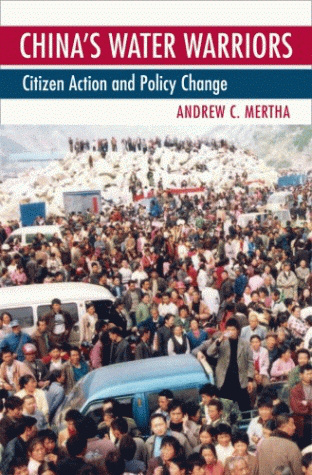Join us for a free one-day workshop for educators at the Japanese American National Museum, hosted by the USC U.S.-China Institute and the National Consortium for Teaching about Asia. This workshop will include a guided tour of the beloved exhibition Common Ground: The Heart of Community, slated to close permanently in January 2025. Following the tour, learn strategies for engaging students in the primary source artifacts, images, and documents found in JANM’s vast collection and discover classroom-ready resources to support teaching and learning about the Japanese American experience.
Mertha, China's Water Warriors, Citizen Action and Policy Change, 2008
Andrew Mertha. China's Water Warriors: Citizen Action and Policy Change. Ithaca Cornell University Press, 2008. xvii + 168 pp. $29.95 (cloth), ISBN 978-0-8014-4636-8.
Reviewed by Baruch Boxer (Stanford University)
Hydrodam Protests and Policy Adjustments in China
In this concise and well-organized book, Andrew Mertha makes several significant contributions. He documents shifts over the  past few decades in Chinese water politics and policies by suggesting new ways of interpreting Kenneth Lieberthal and Michel Oksenberg's widely accepted "fragmented authoritarian" theoretical framework (Policy Making in China, 1988) for analyzing Chinese bureaucratic politics, policies, and governance relating to dam building and resettlement.
past few decades in Chinese water politics and policies by suggesting new ways of interpreting Kenneth Lieberthal and Michel Oksenberg's widely accepted "fragmented authoritarian" theoretical framework (Policy Making in China, 1988) for analyzing Chinese bureaucratic politics, policies, and governance relating to dam building and resettlement.
Popular protests over forced resettlement strongly challenge the long dominant command-and-control authority of the national Ministry of Water Resources and its province-level counterparts.
Mertha assesses public response to potentially disruptive hydropower projects to sort out the various distinctive Chinese elements of concern and protest. Specific contexts addressed include government agency roles at national, provincial, and local levels; NGO inputs; and scientific and engineering assessments. These point up the complexity and changing nature of water politics in China during the present transition from still-prevalent earlier models of bureaucratic control, management, use, and quality assurance of fresh water to currently popular market-based experiments in the energy, agriculture, supply, and pollution control sectors.
Three case studies are revealing and reasonably well documented; however, the author does not use enough Chinese sources in his analysis of differences among the examples of protest to better understand how official and unofficial actors viewed the dynamics and perceived reasons for protest success or failure.
In fall 2004, for example, roughly 100,000 people protested the groundbreaking for the huge Pubugou hydropower dam in western Sichuan province, and the threatened resettlement of half the population of Hanyuan County in which it was located. Here, there was apparently poor communication between the local and provincial levels of the water bureaucracy, with the result that despite the spontaneity, intensity, and scale of the public protests, failure of media and "policy entrepreneurs" (p. 93) to highlight the resettlement issue at higher bureaucratic levels resulted in the matter becoming a "nonevent" (p. 92).
Response to protests since 2003 over dam building on the Nu River (the Salween in Myanmar) in a remote area of southwestern Yunnan Province shows how loosening of control over the activities of domestic and foreign NGOs and media in China since China's early 1980s "opening" to the outside world have facilitated the organization of local protests abetted through the support and encouragement of foreign media and NGOs. The Nu River controversy peaked in November 2008 when national and provincial authorities decided to reconsider construction plans for Tiger Leap Gorge, one of China's most spectacular and biologically diverse river gorges and a UNESCO World Heritage Site. Plans are on hold to consider building a dam upstream close to the China-Tibet border.
I consider the third case of dam-building protest, at Dujiangyan, in western Sichuan Province, near the capital city of Chengdu, the most significant of the three in regard to cultural-historical sensitivities. Besides contemporary flashpoints for protest, like resettlement and economic compensation for lost income when productive agricultural land is flooded by dam reservoirs, Dujiangyan on the Min River has unique significance in China. In the third century BCE, a hydraulically sophisticated irrigation system was built to store, control, and distribute irrigation water to the extensive, fertile Sichuan Basin.
The system has operated without problems to the present, and has been touted as tangible evidence of China's ancient hydraulic engineering skills and accomplishments. Thus, in 2000, when disagreement arose over energy and other economic benefits of dam building versus preservation of a powerful cultural symbol of Chinese engineering prowess, a new element of public concern was introduced which expanded the conventional dimensions and range of actors in dam politics that had emerged in the other cases.
This book is a refreshing and informative investigative foray into the critically important water dimension of the still mostly opaque mechanisms of political and social adjustments underway in the course of China's technological, economic, and geographic modernization. I highly recommend it.
Featured Articles
Please join us for the Grad Mixer! Hosted by USC Annenberg Office of International Affairs, Enjoy food, drink and conversation with fellow students across USC Annenberg. Graduate students from any field are welcome to join, so it is a great opportunity to meet fellow students with IR/foreign policy-related research topics and interests.
RSVP link: https://forms.gle/1zer188RE9dCS6Ho6
Events
Hosted by USC Annenberg Office of International Affairs, enjoy food, drink and conversation with fellow international students.
Join us for an in-person conversation on Thursday, November 7th at 4pm with author David M. Lampton as he discusses his new book, Living U.S.-China Relations: From Cold War to Cold War. The book examines the history of U.S.-China relations across eight U.S. presidential administrations.




